Vacation Bible School at San Andrés


The best part is, that our Christmas tree is a coffee bush! It happened





The best part is, that our Christmas tree is a coffee bush! It happened




On a slightly cloudy, warm day out in the Department of Sonsonate, the Bishop Martín Barahona, Episcopal Relief and Development (ERD) representative Esther Cohen, Rev. Mario Nunez, priest-in-charge of the congregation La Divina Providencia, and other members of the diocese celebrated the official commencement new Anglican Village, La Divina Providencia. The houses were constructed as part of Episcopal Relief and Development's reconstruction work after the 2001 earthquakes. Many volunteers who came to El Salvador through ERD worked hot hours under the sun shoveling dirt, and future home-owners worked weekends to get the houses built. In November a lottery was held among those who had been selected to receive a house-- all families with children, with no substance abuse issues or criminal record, and who had never owned property. The lottery determined which house each family would get, and keys were handed over. The Eucharist and ceremony December 9 officially inaugurated the village, but signs of unofficial inauguration abounded: about five families had moved in, chickens, hammocks, and all (included the lucky family who got the corner house by the school site, and had taken advantage of their suerte to start the first store!) and many others had "inaugurated" their houses by putting in fences, planting gardens, and installing the ubiquitous window-rails. After so many months of visiting El Maizal (the Diocesan property where La Divina Providencia is located), watching the village take shape little by little, it was so exciting to finally see it come to life. The bishop walked through the entire village when the service was over, blessing each of the 30 houses, sprinkling it with holy water. Many future residents, including the owner of the future pupuseria of the village, hurried ahead with their keys to open the doors so he could bless the inside as well.
A Bishop who walks with his people
Bishop Barahona preached about the
kind of community residents should
build at La Divina Providencia
The gathered community
Youth from the community enlivened the celebration with dramatic dance
The house-blessing procession

Advent is my favorite liturgical season. Advent is so very real. It reminds us that we're in the in-between-time, after Jesus came to announce the in-breaking of the Reign of God, and before that reign is brought to its full-ness. It reminds us that we're not there yet, neither individually, nor in our communities, nor as a human family. We are like the people waiting in the dark for the dawn, like the ancient people waiting for its Savior. There is so much to do... and not only to prepare for Christmas. There is so much to do to make this world look more like what God wants it to look like that sometimes it is completely overwhelming. Where to start? The Church starts its liturgical year with this time of waiting. Waiting in the dark during the darkest days of the year, for the light to begin to increase. Waiting for Emanuel, God-with-us, to come again on earth. Reminding ourselves that we are waiting for something. -Amy

The "fiesta patronal," patronal saint's feast, of a church, community, or city is always a big deal in El Salvador. The enthusiasm and love which members of San Andrés put into 


 Clay artisans from Ilobasco have created a series of "sorpresas" surprises, illustrating the journey north
Clay artisans from Ilobasco have created a series of "sorpresas" surprises, illustrating the journey north
“If she leaves, she won’t ever come back,” lamented the young woman’s mother-in-law in low tones to a neighbor after a home bible study. The young woman in question is twenty-three, and is thinking of traveling to the United States with a “coyote” (trafficker in illegal immigration) to find work. She and her husband are fortunate enough to both have jobs in El Salvador, but they make so little that they are now unable to make the payments on their small house (“really it’s a shack,” commented her mother-in-law). Energy prices have more than doubled recently, rising global energy prices being compounded in El Salvador by the simultaneous removal of government subsidies. “I am a penny-pincher,” a woman who lives next to the church told me. “I turn off all the lights we’re not using, and unplug everything except the refrigerator. My bill used to be $8 a month, and now it’s $22.” The recent increase in minimum wage (though most people actually make below minimum wage), from US $160 a month to $170 a month, doesn’t even cover the increase in the electric bill.
young woman in question is twenty-three, and is thinking of traveling to the United States with a “coyote” (trafficker in illegal immigration) to find work. She and her husband are fortunate enough to both have jobs in El Salvador, but they make so little that they are now unable to make the payments on their small house (“really it’s a shack,” commented her mother-in-law). Energy prices have more than doubled recently, rising global energy prices being compounded in El Salvador by the simultaneous removal of government subsidies. “I am a penny-pincher,” a woman who lives next to the church told me. “I turn off all the lights we’re not using, and unplug everything except the refrigerator. My bill used to be $8 a month, and now it’s $22.” The recent increase in minimum wage (though most people actually make below minimum wage), from US $160 a month to $170 a month, doesn’t even cover the increase in the electric bill.
Immigrants from Central America face more dangers traveling by land to the United States than those from Mexico, because of the additional length of their journey, and because they face abuse by the Mexican police if caught. People who immigrate with coyotes often spend their first few years in the US, if they are lucky enough to “pass” and find work, paying off the loans they took out to pay the coyote, whose fees for Central American immigrants range from $5,000 to $10,000 per person. Coyotes do not give refunds if migrants are caught and returned. And those who opt to travel alone face even greater risks, not only of getting caught, but of death or dismemberment from trains, crossing rivers, or in the desert.
This is not a journey people undertake lightly, in order to flaunt the laws of the United States, o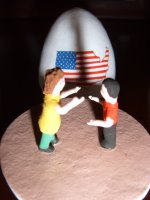 r to steal from its people. People take on the enormous risks of an undocumented journey to the US simply because of economic need, and because the “sueño Americano¨ (American dream) is so effectively sold by the international media and the mall-builders in Latin America. Who wouldn’t rather work at a job that would enable them to afford a designer T-shirt rather than sewing those T-shirts together for $5 a day?
r to steal from its people. People take on the enormous risks of an undocumented journey to the US simply because of economic need, and because the “sueño Americano¨ (American dream) is so effectively sold by the international media and the mall-builders in Latin America. Who wouldn’t rather work at a job that would enable them to afford a designer T-shirt rather than sewing those T-shirts together for $5 a day?
To me the most tragic effect of migration is the breaking apart of families. The 23-year-old woman, if she migrates, will not see her five-year-old son or her husband for years, if she sees them again at all. There are numerous children in our school who have one or both parents in the US (one small boy is now the only member of his immediate family still in El Salvador); their struggles and sense of abandonment show up in their academic difficulties and behavioral acting-out.
The Church does not promote or encourage illegal immigration. Bishop Barahona has been instrumental in founding two migration-related organizations: one non-profit that helps people seek legal means to immigrate to the US, and another which helps deportees re-integrate into life in El Salvador. We try to educate people about the risks of going, and encourage young people to seek higher education in order to get ahead and make a contribution to bettering the situation in their home country. But when people have made up their mind, there is little more we can do. I give them a cross or a small bible, a pamphlet on the human rights of migrants, pray with them for their safety and for their family. I pray that our migrant Savior, who was a refugee in Egypt, may go with them on their way.
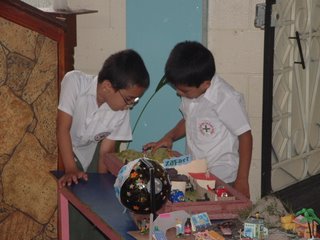 Above: One student offers an explanation of his project
Above: One student offers an explanation of his project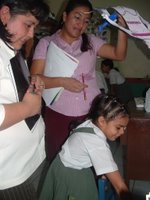
As the school year neared an end, students at Colegio Episcopal San Andrés Apóstol got a chance to show off what they had learned at the school science fair. The panel of judges reviewed the projects of students from kindergarden up to sixth grade, as parents looked on and children nervously awaited their turn to explain their project. The winning project in the upper grades was presented by 5th grader Mayra Aguilar, who gave a med-school worthy explanation of the process of human gestation and birth.
grader Mayra Aguilar, who gave a med-school worthy explanation of the process of human gestation and birth.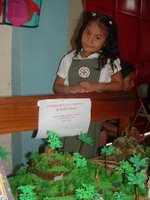
Rt.:Mayra Aguilar and her winning project on the birth process.
Lt.: Lissbeth Escobar stands above her detailed project onthe negative effects of deforestation in El Salvador.
Below: Students and parents mill about inside the church for the science fair 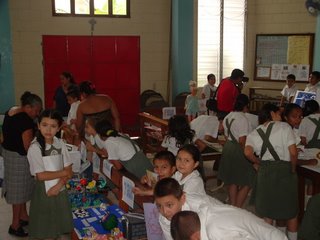

Folkloric Dancers from the diocesan youth group perform at the dinner held in honor of the Anglican women of El Salvador
October is celebrated as "The Month of the Anglican Woman" in the Province of Central America, and it was well celebrated this year in the Diocese of El Salvador! The Diocesan 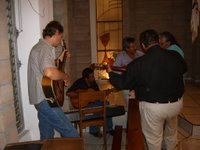 Commission on Women's Ministry hosted a vigil, at which Amy and four other women from the diocese gave talks on "spiritual healing" for ourselves, our families, our communities, and our
Commission on Women's Ministry hosted a vigil, at which Amy and four other women from the diocese gave talks on "spiritual healing" for ourselves, our families, our communities, and our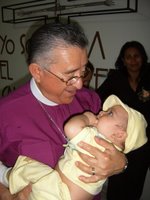 church. Each talk was over an hour long, a combined band from several of the local churches (a number of whom have studied guitar with Vince) enlivened the worshippers at intervals, and the vigil ended with the Holy Eucharist at 6AM!
church. Each talk was over an hour long, a combined band from several of the local churches (a number of whom have studied guitar with Vince) enlivened the worshippers at intervals, and the vigil ended with the Holy Eucharist at 6AM!
A week later over 200 women, men, youth, and children enjoyed a "Prayer Dinner" hosted by the Diocesan Women's Commission. Women representing all of the congregations in the diocese were present and gave messages, a group of young women from San Salvador area churches enlivened us with traditional folk dance, and a wonderful time was had by all. 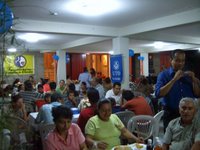
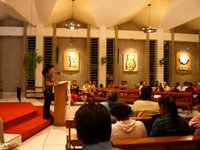 Lt.-People from around the diocese enjoy the annual dinner. Rt.- San Andres Apostol vestry member Vilma Ayala gives a sermon at the all night vigil
Lt.-People from around the diocese enjoy the annual dinner. Rt.- San Andres Apostol vestry member Vilma Ayala gives a sermon at the all night vigil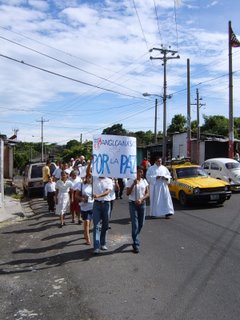 Not to be left out, the churches in the greater Soyapango area to the east of San Salvador (San Andrés in Amatapec, Santa María Vírgen in Ilopango, and Santísima Trinidad in San Martín) hosted a ¨Mini-Congress" on women's ministry, lay and ordained, in the church. The mini-congreso began with a two-mile march for peace from the main boulevard that connects our communities (ironically, Boulevard de los Ejercitos, "Army Boulevard") up to San Andrés.
Not to be left out, the churches in the greater Soyapango area to the east of San Salvador (San Andrés in Amatapec, Santa María Vírgen in Ilopango, and Santísima Trinidad in San Martín) hosted a ¨Mini-Congress" on women's ministry, lay and ordained, in the church. The mini-congreso began with a two-mile march for peace from the main boulevard that connects our communities (ironically, Boulevard de los Ejercitos, "Army Boulevard") up to San Andrés.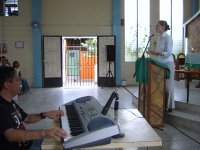 All three of our communities have been heavily hit by violence over the past few months, and young men associated with both San Andrés and Santa María Vírgen have been killed in the gang's cross-fire. The march, in which about 40 people all dressed in white partipated, drew a lot of attention in the community. Once we arrived at the church, we continued singing some very enlivening songs, as Vince said "we freakin' rocked the joint!", and heard an encouraging message from Padre Julio of Santa María Vírgen. Speaking on the raising of Lazarus he said, ¨Christ asked the people to roll away the stone. That was possible for them. They couldn´t raise the dead. But they could roll away the stone. Christ asks us to do what is possible for us, and to leave the impossible to him, because God is a specialist in the impossible!¨ Amy gave a talk which answered theological and biblical objections to women´s ordained ministry, empowering people to explain these things to others who don´t understand in this heavily
All three of our communities have been heavily hit by violence over the past few months, and young men associated with both San Andrés and Santa María Vírgen have been killed in the gang's cross-fire. The march, in which about 40 people all dressed in white partipated, drew a lot of attention in the community. Once we arrived at the church, we continued singing some very enlivening songs, as Vince said "we freakin' rocked the joint!", and heard an encouraging message from Padre Julio of Santa María Vírgen. Speaking on the raising of Lazarus he said, ¨Christ asked the people to roll away the stone. That was possible for them. They couldn´t raise the dead. But they could roll away the stone. Christ asks us to do what is possible for us, and to leave the impossible to him, because God is a specialist in the impossible!¨ Amy gave a talk which answered theological and biblical objections to women´s ordained ministry, empowering people to explain these things to others who don´t understand in this heavily 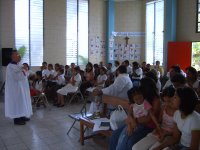 Roman Catholic context. Bishop Barahona arrived, vested in white (just a little too late for the march!) and spoke movingly about his experience with women´s ministry in the church. ¨We are very, very close to ordaining the first Salvadoran woman in El Salvador,¨ he said (the three women Bishop Barahona has ordained in El Salvador have all been North Americans). The mini-congreso closed with a Eucharist, at which Bishop Barahona presided, and just under 200 people were present. The people gathered signed a card of congratulations and support for Presiding Bishop Katharine Jefferts Schori. It was truly moving to share this event with our closest neighbor congregations, and we plan to have a lot more shared events in the future.
Roman Catholic context. Bishop Barahona arrived, vested in white (just a little too late for the march!) and spoke movingly about his experience with women´s ministry in the church. ¨We are very, very close to ordaining the first Salvadoran woman in El Salvador,¨ he said (the three women Bishop Barahona has ordained in El Salvador have all been North Americans). The mini-congreso closed with a Eucharist, at which Bishop Barahona presided, and just under 200 people were present. The people gathered signed a card of congratulations and support for Presiding Bishop Katharine Jefferts Schori. It was truly moving to share this event with our closest neighbor congregations, and we plan to have a lot more shared events in the future.
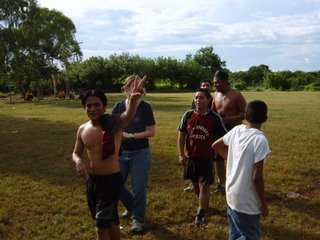 Team members celebrate after winning the finals match.
Team members celebrate after winning the finals match.
We arrived back from a short trip to California just in time to attend the "Copa del Obispo," the ¨Bishop´s Cup,¨ a male and female youth soccer tournament sponsored annually by the 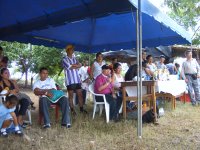 Anglican Episcopal Church of El Salvador, this year on October 7 at El Maizal, the Diocesan agricultural development in Sonsonate. And, somewhat jet-lagged, we arrived at the Copa just in time to see the male team from San Andrés win the championship! The last thing I knew before we left, San Andrés was not going to present a team, as most of the youth had to work. But, they got it together, and, despite transportation problems (their bus ran out of gas halfway there), made it to the tournament. Even though they had few replacements and hadn't practiced, they played energetically and took the Cup!
Anglican Episcopal Church of El Salvador, this year on October 7 at El Maizal, the Diocesan agricultural development in Sonsonate. And, somewhat jet-lagged, we arrived at the Copa just in time to see the male team from San Andrés win the championship! The last thing I knew before we left, San Andrés was not going to present a team, as most of the youth had to work. But, they got it together, and, despite transportation problems (their bus ran out of gas halfway there), made it to the tournament. Even though they had few replacements and hadn't practiced, they played energetically and took the Cup!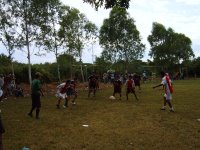
who often have little opportunity for recreation. Of course people follow the games-- when Barcelona and Real Madrid play there's hardly anyone out (and forget going to the grocery store during the World Cup!)-- but just playing is almost as important, for everyone from kids kicking Soccer in the United States is not a good reference point for understanding ¨fútbol¨ in Latin America. Here, it is a passion. It is an incredible outlet of energy, especially among the youth, a hard plastic ball around in the streets to organized leagues in every small country municipality.
The San Andrés youth have been energized by their victory (this is the 3rd cup they´ve won in the eight year history of the tournament!) and plan to continue playing, planning soccer ¨encounters¨where they will go out and worship and play with the youth from other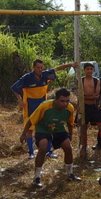 congregations around the country. They have dedicated their victory to Jorge Alberto Enriquez, who helped them to victory as goalie, and as his father commented, was a great soccer "aficcionado". Jorge was an active member of the church when he was younger. He turned 21 the day before the tournament, and just two weeks later, on October 22, was brutally killed by gang members from the neighboring territory, who mistook him for a member of the rival gang. ¨I hardly ever leave my house these days,¨ said our youth group president and team captain Luis Daniel Escobar at a youth meeting a couple of weeks later. ¨And when I leave to go to work, I wonder if I´ll come back.¨ Luis Daniel´s cousin was killed by the gangs a year ago in another case of mistaken identity. Everyone is nervous these days, but it´s the youth, especially the guys, that face the most danger every single day. The church needs to be there for them, to support them and encourage them in every way that we can. -Amy
congregations around the country. They have dedicated their victory to Jorge Alberto Enriquez, who helped them to victory as goalie, and as his father commented, was a great soccer "aficcionado". Jorge was an active member of the church when he was younger. He turned 21 the day before the tournament, and just two weeks later, on October 22, was brutally killed by gang members from the neighboring territory, who mistook him for a member of the rival gang. ¨I hardly ever leave my house these days,¨ said our youth group president and team captain Luis Daniel Escobar at a youth meeting a couple of weeks later. ¨And when I leave to go to work, I wonder if I´ll come back.¨ Luis Daniel´s cousin was killed by the gangs a year ago in another case of mistaken identity. Everyone is nervous these days, but it´s the youth, especially the guys, that face the most danger every single day. The church needs to be there for them, to support them and encourage them in every way that we can. -Amy
Team Captain Luis Daniel receives the Champions trophy from Bishop Barahona Team photo with La Reverenda
Team photo with La Reverenda
 Our newest member of the clergy is presented to Bishop Barahona for reception as a Deacon.
Our newest member of the clergy is presented to Bishop Barahona for reception as a Deacon.
Julio Rivera, 36, was received on October 14, 2006 as a deacon in the Anglican Episcopal Church of El Salvador, bringing our total number of clergy up to 13! Julio was ¨received¨ as a deacon because he was already ordained as a Roman Catholic priest; the Anglican Church recognizes Roman Catholic orders and so does not re-ordain its clergy when they seek to join the Anglican Church. Those clergy from the Roman Catholic Church seeking reception into the Anglican Church of El Salvador undergo an intense process and spend a year of intensive Anglican study at the Anglican Seminary in Mexico City. Julio took all of the vows in the Prayer Book service for the ordination of a deacon, but rather than laying his hands on Julio's head, Bishop Barahona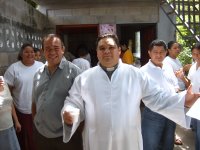 took his hand and said, "Julio, we recognize you as a Deacon in Christ's One, Holy, Catholic, and Apostolic Church." In his sermon, Bishop Barahona likened this reception to "untying Julio's hands," which had been "tied" when he left the Roman Catholic Church, for deaconal ministry. When Julio is received as a priest, Bishop Barahona said, we will "untie his feet."
took his hand and said, "Julio, we recognize you as a Deacon in Christ's One, Holy, Catholic, and Apostolic Church." In his sermon, Bishop Barahona likened this reception to "untying Julio's hands," which had been "tied" when he left the Roman Catholic Church, for deaconal ministry. When Julio is received as a priest, Bishop Barahona said, we will "untie his feet."
Julio is the second-youngest member of the clergy in the diocese (after Amy!) and brings a lot of energy and fresh ideas about evangelism and pastoral work. He is re-organizing the pastoral life of Santa María Virgen in Ilopango, where he has been assigned, around a ¨small community¨ model, which draws both on liberation theology´s base Christian communities and Evangelical ¨cell groups.¨ The small communities will meet weekly in people´s homes in the different geographical zones of the parish (which he is explaining to priests from the U.S. in the picture), and will become ¨nurseries¨of Christian formation and outreach.
¨cell groups.¨ The small communities will meet weekly in people´s homes in the different geographical zones of the parish (which he is explaining to priests from the U.S. in the picture), and will become ¨nurseries¨of Christian formation and outreach.
Julio himself has an amazing story of growing up in El Salvador during the Civil War. His village was bombed by the government early on during the war, and he was separated from his parents and picked up by the Red Cross 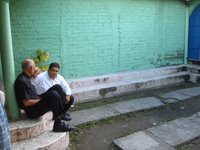 as an orphan. He was raised by a Roman Catholic priest until the war was over, and then, after finding out that his parents, who had fought with the guerilla, were actually still alive, was then reunited with them. Julio's father passed away last year, but his mother was present at his reception.
as an orphan. He was raised by a Roman Catholic priest until the war was over, and then, after finding out that his parents, who had fought with the guerilla, were actually still alive, was then reunited with them. Julio's father passed away last year, but his mother was present at his reception.
